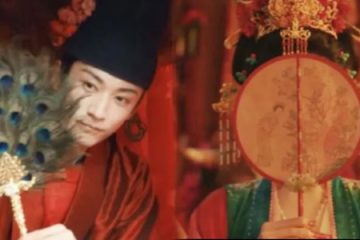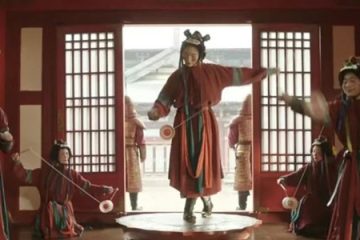Who Can’t Hold Back When Zhuang Hanyan Pulls Out the Gun in The Glory?

In the ancient costume drama The Glory, when Zhuang Hanyan took out the firelock, I wonder how many people’s hearts skipped a beat? Netizens asked: Sister Yan, where did you get that firelock? Which do you think looks more beautiful, the combination of the firelock and Hanfu, or Hanfu paired with a sword? There is a kind of beauty that transcends the times. However, to be honest, the combination of Hanfu and a firelock doesn’t really transcend the times. We can also take this opportunity to talk about some historical records of firearms in certain dynasties in China.

In the ancient costume drama The Glory, when Zhuang Hanyan took out the firelock, I wonder how many people’s hearts skipped a beat? Netizens asked: Sister Yan, where did you get that firelock? Which do you think looks more beautiful, the combination of the firelock and Hanfu, or Hanfu paired with a sword? There is a kind of beauty that transcends the times. However, to be honest, the combination of Hanfu and a firelock doesn’t really transcend the times. We can also take this opportunity to talk about some historical records of firearms in certain dynasties in China.
I. From the Yuan Dynasty
In fact, firelocks have appeared in some TV series and movies like Joy of Life Season 2 and Blossom. Let’s start with the conclusion. Chinese ancient ancestors were not only gentle and kind but also very cool and handsome. The firelock was first created in the Yuan Dynasty of China. It evolved from the Tu Huo Qiang (a kind of early firearm) in the Southern Song Dynasty and is the world’s earliest tubular metal shooting firearm (this is the key point). That’s right. The Ming Dynasty had already taken the lead in entering the era of hot weapons. At this time, you can just shout: Sir, the times have changed!

During the Yuan Dynasty, the technology for casting firearms had reached a highly sophisticated level. Metal barrels could be made for firearms. For example, bronze and iron were common casting materials for firearms. Even before Zhu Yuanzhang established the Ming Dynasty, the production of firelocks had already become the main focus.
After the establishment of the Ming Dynasty, the production of firelocks was promoted on a large scale. In the 13th year of the Hongwu reign, the Ming government stipulated that each local military garrison should be equipped with firelocks accounting for 10% of their establishment number. In the 8th year of the Yongle reign, a special Shenji Camp was established. All 3,600 infantrymen in this camp were equipped with firearms. You can really feel the imposing manner of the firelock army.

Moreover, the craftsmanship of firelocks was constantly evolving. There were both introductions of foreign technologies and independent research and development, and it was in a continuous process of learning. For those who are interested in traditional Chinese clothing, it’s quite an interesting connection.
For instance, according to the record in Volume 62 of Taizong Shilu, during the Yongle reign, when the Ming army attacked Annam (present-day Vietnam), it obtained the advanced manufacturing technology of firelocks, and thus improved the craftsmanship. The main improvement was made to the barrel, enabling it to hold more gunpowder. Through adjustments to details such as the inner diameter of the barrel, the speed at which the gunpowder passed through the barrel was increased, enhancing the power of the firelock.

It is recorded in Supplementary Expositions on the Great Learning: “Recently, there is a kind of divine firelock. It uses iron to make arrowheads, and is fired by fire. It can reach a distance of more than a hundred paces. It is as ingenious and miraculous as a god. Before you can even finish hearing the sound, the arrow has already arrived. During the Yongle reign, when the Ming Dynasty pacified Jiaozhi (present-day Vietnam), the ones made by the locals were especially ingenious.
The imperial eunuchs were ordered to supervise the manufacturing according to their methods. Within the capital, a great general was appointed to command the Shenji Camp, and at the border areas, imperial eunuchs were appointed to supervise the divine firelocks. This shows how cautious they were about it.”

II. Details of the Firelock
A firelock is usually composed of three parts: the barrel (the front part of the bore), the powder chamber, and the socket at the tail. Its working principle is that when the gunpowder in the powder chamber is ignited, it generates an explosive force that propels the objects inside the bore out to attack. In the work Blossom, when Song Mo teaches Dou Zhao how to use a firelock, he specifically pays attention to covering his ears. This is exactly to block the loud noise generated by the explosive force.


Why can women also use firelocks? Because some portable firelocks are not as heavy as you might think. After all, it needs to be held by hand and allow for precise control. For example, the Yuan Dynasty bronze firelock unearthed in the eastern suburb of Xi’an in 1974 is 26.5 centimeters long and weighs 1.78 kilograms, which is actually very convenient to carry.
In 1635, Bi Maokang of the Ming Dynasty wrote a book about firearms called Illustrated Exposition of Military Weapons. This book lists in detail the patterns and introductions of various firearms, and describes, with both texts and pictures, the knowledge about the manufacturing, usage, and power of military weapons.

III. Details of the Matchlock
The matchlock is also a great invention in the improvement of long-range weapons. Traditional firelocks required two hands to operate: one hand held the slow match, and the other hand held the firelock. After igniting the slow match, it would set off the gunpowder for firing, which made it impossible to aim accurately.
The innovation of the matchlock lies in its long barrel, the beak-shaped stock, and the semi-mechanical ignition device, enabling the shooter to aim closely with the face against the stock. This greatly improves the shooting accuracy, stability, and safety.

Its principle is to fix the pre-burning slow match beside the powder chamber. When the trigger is pulled, the slow match falls in and ignites the gunpowder, propelling the bullet out. This improvement has increased the efficiency and lethality, making the matchlock the main weapon of the Ming army. According to the record in Collected Statutes of the Great Ming Dynasty: Firearms, in the 37th year of the Jiajing reign (1558), the Ming Dynasty manufactured as many as 10,000 matchlocks.

Summary
In addition, there were mainly two types of firearm armaments in the Ming Dynasty: one was handheld, and the other was mounted on a cannon. Besides traditional firelocks and matchlocks, there were also San Yan Chong (a three-barreled firearm), Yi Wo Feng (a multi-shot rocket), Lian Zhu Pao (a multi-shot cannon), Hu Dun Pao (a cannon), curved-trajectory long-distance cannons, flat-trajectory large iron-ball cannons, and explosive weapons such as landmines and naval mines.
It can be said that the development of hot weapons in the Ming Dynasty was far more advanced than many people might imagine. Therefore, in the future, if you see a firelock in a Ming Dynasty drama, there’s no need to be too surprised, because after all, it was once an invention that led the world.
Now, if you’ve bought Hanfu from the Ming or Qing Dynasty and you want to create a slightly “different” outfit combination, you can try not using a fan or a sword as an accessory, but instead, use a firearm! Wouldn’t that be really interesting?




0 Comments